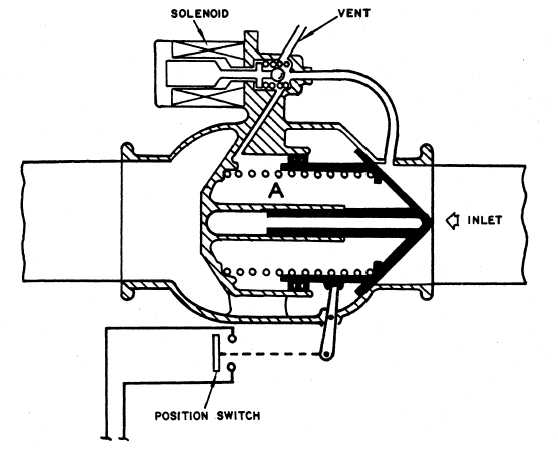When the solenoid is not energized, chamber
B is vented to ambient pressure and the
valve sleeve remains in the closed position.
To activate the system, the solenoid is en-
ergized, which enables reference control air
pressure to reach chamber B to overcome sleeve
spring force and start to open the valve sleeve.
If the inlet pressure is only ambient pressure, the
sleeve remains fully closed. A 2 psi margin
of inlet pressure over outlet pressure starts the
sleeve opening action. When inlet pressure reaches
30 psi absolute (psia) and outlet pressure is
at the 26±2 psia setpoint, the valve sleeve
opens. Further increase of inlet pressure,
which would otherwise cause an increase
in outlet pressure, is sensed in chamber A,
which adds to the closing force of the valve
sleeve. As the valve sleeve moves toward a
more closed position, the outlet pressure is
reduced and the 26±2 psia setpoint is main-
tained. Continued increase of inlet pressure
results in continued valve sleeve closure until
the pressure regulator valve is completely
closed, thereby preventing outlet pressure from
exceeding 28 psia.
Bleed-Air Solenoid Valve
Eight cyclic valves are used in the deice system.
Two cyclic valves are located in each outboard
wing, one in each inboard wing, and one in each
horizontal stabilizer. The cyclic valve is normally
spring-loaded closed, electrically controlled, and
pneumatically actuated. The cyclic valve controls
the cyclic distribution of bleed air to the
appropriate segment of the deice system piccolo
tubes.
The cyclic valve is pneumatically controlled
by a bleed-air solenoid valve (fig. 1-13). When the
solenoid is not energized, the spring keeps the
cyclic valve closed, and inlet pressure is vented
to ambient and to the closing side of the valve
(chamber A). When the solenoid is energized, the
inlet pressure is blocked, and when it builds to
Figure 1-13.—Bleed-air solenoid valve.
1-16

